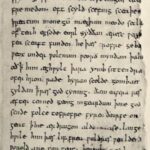Old English was one of the first local languages to be written down, and was used in parts of England and southern Scotland from the mid 5th century to the mid 12th century. It’s called Anglo Saxon, and was the early form of what we now call the English Alphabet.
Sources from this period are scarce, although some do exist. Literature written in Old English was mostly done by anonymous authors, with poetry at the core. Bede was an exception to this, as he has become well-known for his work. Another well known work written in Old English, is Beowulf.
The Old English Alphabet was modified and updated throughout the years, until it became how we know it today. From the 5th century it was written in the Runic alphabet, and it was not until another 200 years that the Latin alphabet began to take over. Pieces of the runes influenced the latin alphabet however, and gave it letters such as thorn and eth. Thorn and eth are obsolete in today’s alphabet, as they are replaced with ‘th’.
In 1011 a writer by the name of Byrhtferð ordered the Latin alphabet by using 24 letters we know in today’s alphabet, as well as with five additional Old English letters. From there the alphabet was modified further until it became how we know it today. Further reading can be found at Omniglot.
To write old English is with some exceptions fairly simple. For starters these three characters were present in the Old English Alphabet, but are excluded today.
Æ(æ) was pronounced like the ‘a’ in ‘hat’.
Þ (thorn) was like ‘th’ in ‘this’.
Ð (ð) (eth) was just like thorn, used to represent ‘th’.
Next follows the letters in the modern day alphabet, which are very similar to how we write them today. The pictures give illustrations on the vowels and consonants, as well as the letters we do not currently have in today’s language.
The first letter that require attention (the ones before can be written like in modern English), is ‘G’. The capital letter is written with straight lines, as compared to today’s curved lines. The ‘g’ however, is written like a 5, with half the letter under the line.
Capital ‘H’ is written like today’s ‘h’, and the capital letter is distinguished from the small with having more width.
‘I’, ‘L’, ‘M’, ‘N’, ‘O’ and ‘P’ were in Old English written like in today’s language. Take notice of the fact that there was no ‘J’ or ‘K’.
Capital ‘R’ was written like we write it today, but in the small letter, ‘r’ was written like a ‘p’ without a closing circle.
‘S’ was a unique letter, and the best way to describe it is by looking at the picture. Both the capital and small letter consists of two letters.
Capital ‘T’ was also written like in today’s alphabet, but the small letter resembles the capital only smaller in size.
‘U’, ‘X’, and ‘Y’, were very similar to how we write them today.
The differences in writing style are generally small, but when looking at an Old English text it can be hard for the untrained eye to read it. With a little practice however, and when one remembers æ, eth, and thorn it’s not an impossible task to learn how to read and write Old English.



